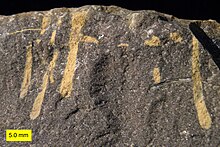
The Ordovician is a geologic period and system, the second of six periods of the Paleozoic Era. The Ordovician spans 41.6 million years from the end of the Cambrian Period 485.4 Ma to the start of the Silurian Period 443.8 Ma.

The Silurian is a geologic period and system spanning 24.6 million years from the end of the Ordovician Period, at 443.8 million years ago (Mya), to the beginning of the Devonian Period, 419.2 Mya. The Silurian is the shortest period of the Paleozoic Era. As with other geologic periods, the rock beds that define the period's start and end are well identified, but the exact dates are uncertain by a few million years. The base of the Silurian is set at a series of major Ordovician–Silurian extinction events when up to 60% of marine genera were wiped out.
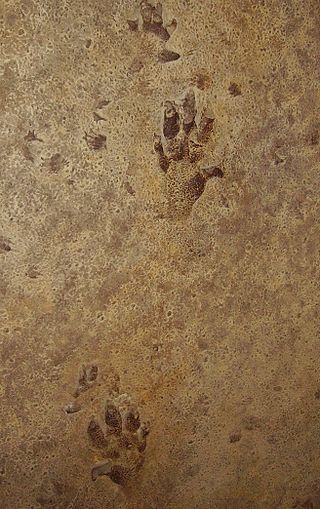
A trace fossil, also known as an ichnofossil, is a fossil record of biological activity by lifeforms but not the preserved remains of the organism itself. Trace fossils contrast with body fossils, which are the fossilized remains of parts of organisms' bodies, usually altered by later chemical activity or mineralization. The study of such trace fossils is ichnology and is the work of ichnologists.
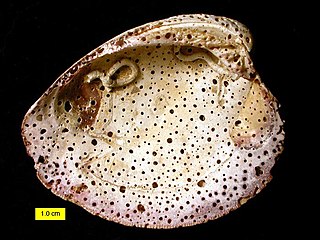
Bioerosion describes the breakdown of hard ocean substrates – and less often terrestrial substrates – by living organisms. Marine bioerosion can be caused by mollusks, polychaete worms, phoronids, sponges, crustaceans, echinoids, and fish; it can occur on coastlines, on coral reefs, and on ships; its mechanisms include biotic boring, drilling, rasping, and scraping. On dry land, bioerosion is typically performed by pioneer plants or plant-like organisms such as lichen, and mostly chemical or mechanical in nature.

A calcite sea is a sea in which low-magnesium calcite is the primary inorganic marine calcium carbonate precipitate. An aragonite sea is the alternate seawater chemistry in which aragonite and high-magnesium calcite are the primary inorganic carbonate precipitates. The Early Paleozoic and the Middle to Late Mesozoic oceans were predominantly calcite seas, whereas the Middle Paleozoic through the Early Mesozoic and the Cenozoic are characterized by aragonite seas.

Carbonate hardgrounds are surfaces of synsedimentarily cemented carbonate layers that have been exposed on the seafloor. A hardground is essentially, then, a lithified seafloor. Ancient hardgrounds are found in limestone sequences and distinguished from later-lithified sediments by evidence of exposure to normal marine waters. This evidence can consist of encrusting marine organisms, borings of organisms produced through bioerosion, early marine calcite cements, or extensive surfaces mineralized by iron oxides or calcium phosphates. Modern hardgrounds are usually detected by sounding in shallow water or through remote sensing techniques like side-scan sonar.

An aragonite sea contains aragonite and high-magnesium calcite as the primary inorganic calcium carbonate precipitates. The chemical conditions of the seawater must be notably high in magnesium content relative to calcium for an aragonite sea to form. This is in contrast to a calcite sea in which seawater low in magnesium content relative to calcium favors the formation of low-magnesium calcite as the primary inorganic marine calcium carbonate precipitate.

Cornulitida is an extinct order of encrusting animals from class Tentaculita, which were common around the globe in the Ordovician to Devonian oceans, and survived until the Carboniferous. Organisms that may be the oldest cornulitids have been found in Cambrian sediments of Jordan.
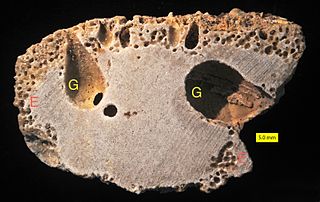
Gastrochaenolites is a trace fossil formed as a clavate (club-shaped) boring in a hard substrate such as a shell, rock or carbonate hardground. The aperture of the boring is narrower than the main chamber and may be circular, oval, or dumb-bell shaped. Gastrochaenolites is most commonly attributed to bioeroding bivalves such as Lithophaga and Gastrochaena. The fossil ranges from the Ordovician to the Recent. The first Lower Jurassic Gastrochaenolites ichnospecies is Gastrochaenolites messisbugi Bassi, Posenato, Nebelsick, 2017. This is the first record of boreholes and their producers in one of the larger bivalves of the globally occurring Lithiotis fauna which is a unique facies in the Lower Jurassic Tethys and Panthalassa.
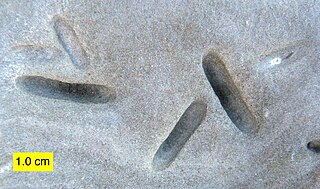
Petroxestes is a shallow, elongate boring originally found excavated in carbonate skeletons and hardgrounds of the Upper Ordovician of North America. These Ordovician borings were likely made by the mytilacean bivalve Corallidomus as it ground a shallow groove in the substrate to maintain its feeding position. They are thus the earliest known bivalve borings. Petroxestes was later described from the Lower Silurian of Anticosti Island (Canada). and the Miocene of the Caribbean.

Rogerella is a small pouch-shaped boring with a slit-like aperture currently produced by acrothoracican barnacles. These crustaceans extrude their legs upwards through the opening for filter-feeding. They are known in the fossil record as borings in carbonate substrates from the Devonian to the Recent.

Entobia is a trace fossil in a hard substrate formed by sponges as a branching network of galleries, often with regular enlargements termed chambers. Apertural canals connect the outer surface of the substrate to the chambers and galleries so the sponge can channel water through its tissues for filter feeding. The fossil ranges from the Devonian to the Recent.

Sphenothallus is a problematic extinct genus lately attributed to the conulariids. It was widespread in shallow marine environments during the Paleozoic.

Helminthopsis is the ichnogenus of a type of trace fossil that is found preserved on the bedding planes of fine-grained sedimentary rocks. It is characterized by short, curvilinear, non-branching, parallel-sided, unlined traces on bedding surfaces. It is thought to represent the submarine feeding trails of an invertebrate organism that worked the surface of muddy substrates in search of food. Because Helminthopsis traces never cross over themselves, the ichnogenus is distinguished from similar traces assigned to the Gordia ichnogenus. The similar sounding, but now obsolete, ichnogenus Helminthoida refers to a somewhat similar trace characterized by regular, back-and-forth meanders, whereas Helminthopsis traces are irregular.

Anticalyptraea is a fossil genus of encrusting tentaculitoid tubeworms from the Silurian to Devonian of Europe and North America . Anticalyptraea commonly encrust various invertebrate fossils such as stromatoporoids, rugose corals, bryozoans, brachiopods and crinoids, but they can also be common on the hardgrounds.

Osprioneides is an ichnogenus of unbranched, elongate borings in lithic substrate with oval cross−section, single−entrance and straight, curved or irregular course. Osprioneides kampto Beuck and Wisshak, 2008 is the largest known Palaeozoic boring trace. It occurs in the Ordovician and Silurian (Wenlock) of Baltica. The borings are up to 120 mm long measuring 5–17 mm in diameter. The distribution of Osprioneides is more environmentally limited than that of Trypanites in the Silurian of Saaremaa, Estonia (Baltica). Osprioneides probably occurred only in large hard substrates of relatively deepwater muddy bottom open shelf environments. Osprioneides were relatively rare, as compared to Trypanites-Palaeosabella borings in the Wenlock of Saaremaa.
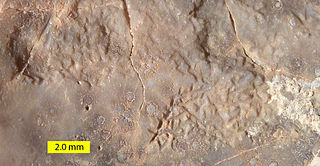
Gnathichnus is a trace fossil on a hard substrate formed by regular echinoids as they scraped the surface with their five-toothed Aristotle's Lantern feeding structures.
Anoigmaichnus is an ichnogenus of bioclaustrations. Anoigmaichnus includes shafts perpendicular to their hosts' growth surfaces or tilted (up to 45°); conical to cylindrical; circular to oval cross-sections; lacking separate wall. Their apertures are elevated above their hosts' growth surfaces, forming short chimney-like structures. Anoigmaichnus is the world's earliest known macroscopic endobiotic symbiont and it may have been a parasite. It occurs in the Middle Ordovician bryozoans of Osmussaar Island, Estonia.
Tremichnus is an ichnogenus or trace fossil. It is an embedment structure formed by an organism that inhibited growth of the crinoid host stereom. The most common endobiotic symbiont in Paleozoic crinoids is Tremichnus
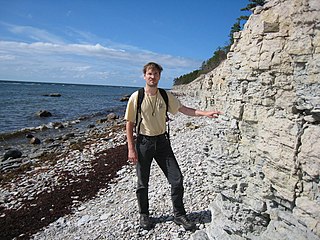
Olev Vinn is Estonian paleobiologist and paleontologist.

